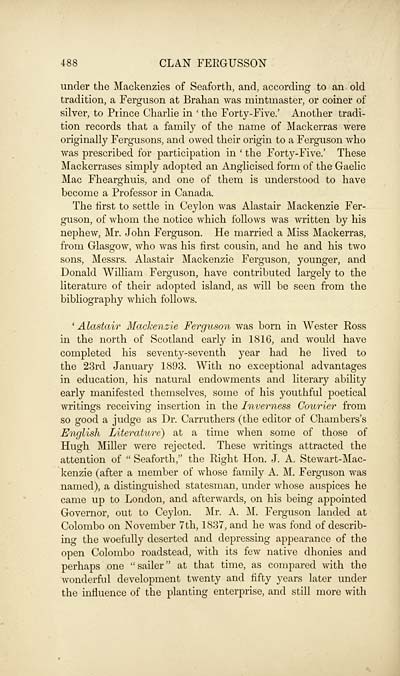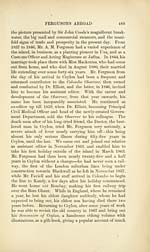Download files
Complete book:
Individual page:
Thumbnail gallery: Grid view | List view

488 CLAN FERGUSSON
under the Mackenzies of Seaforth, and, according to an old
tradition, a Ferguson at Brahan was mintmaster, or coiner of
silver, to Prince Charlie in ' the Forty-Five.' Another tradi-
tion records that a family of the name of Mackerras were
originally Fergusons, and owed their origin to a Ferguson who
was prescribed for participation in ' the Forty-Five.' These
Mackerrases simply adopted an Anglicised form of the Gaelic
Mac Fhearghuis, and one of them is understood to have
become a Professor in Canada.
The first to settle in Ceylon was Alastair Mackenzie Fer-
guson, of whom the notice which follows was written by his
nephew, Mr. John Ferguson. He married a Miss Mackerras,
from Glasgow, who was his first cousin, and he and his two
sons, Messrs. Alastair Mackenzie Ferguson, younger, and
Donald William Ferguson, have contributed largely to the
literature of their adopted island, as will be seen from the
bibliography which follows.
' Alastair Mackenzie Ferguson was born in Wester Ross
in the north of Scotland early in 1816, and would have
completed his seventy-seventh year had he lived to
the 23rd January 1893. With no exceptional advantages
in education, his natural endowments and literary ability
early manifested themselves, some of his youthful poetical
writings receiving insertion in the Inverness Courier from
so good a judge as Dr. Carruthers (the editor of Chambers's
English Literature) at a time when some of those of
Hugh Miller were rejected. These writings attracted the
attention of " Seaforth," the Right Hon. J. A. Stewart-Mac-
kenzie (after a member of whose family A. M. Ferguson was
named), a distinguished statesman, under whose auspices he
came up to London, and afterwards, on his being appointed
Governor, out to Ceylon. Mr. A. M. Ferguson landed at
Colombo on November 7th, 1837, and he was fond of describ-
ing the woefully deserted and depressing appearance of the
open Colombo roadstead, with its few native dhonies and
perhaps one "sailer" at that time, as compared with the
wonderful development twenty and fifty years later under
the influence of the planting enterprise, and still more with
under the Mackenzies of Seaforth, and, according to an old
tradition, a Ferguson at Brahan was mintmaster, or coiner of
silver, to Prince Charlie in ' the Forty-Five.' Another tradi-
tion records that a family of the name of Mackerras were
originally Fergusons, and owed their origin to a Ferguson who
was prescribed for participation in ' the Forty-Five.' These
Mackerrases simply adopted an Anglicised form of the Gaelic
Mac Fhearghuis, and one of them is understood to have
become a Professor in Canada.
The first to settle in Ceylon was Alastair Mackenzie Fer-
guson, of whom the notice which follows was written by his
nephew, Mr. John Ferguson. He married a Miss Mackerras,
from Glasgow, who was his first cousin, and he and his two
sons, Messrs. Alastair Mackenzie Ferguson, younger, and
Donald William Ferguson, have contributed largely to the
literature of their adopted island, as will be seen from the
bibliography which follows.
' Alastair Mackenzie Ferguson was born in Wester Ross
in the north of Scotland early in 1816, and would have
completed his seventy-seventh year had he lived to
the 23rd January 1893. With no exceptional advantages
in education, his natural endowments and literary ability
early manifested themselves, some of his youthful poetical
writings receiving insertion in the Inverness Courier from
so good a judge as Dr. Carruthers (the editor of Chambers's
English Literature) at a time when some of those of
Hugh Miller were rejected. These writings attracted the
attention of " Seaforth," the Right Hon. J. A. Stewart-Mac-
kenzie (after a member of whose family A. M. Ferguson was
named), a distinguished statesman, under whose auspices he
came up to London, and afterwards, on his being appointed
Governor, out to Ceylon. Mr. A. M. Ferguson landed at
Colombo on November 7th, 1837, and he was fond of describ-
ing the woefully deserted and depressing appearance of the
open Colombo roadstead, with its few native dhonies and
perhaps one "sailer" at that time, as compared with the
wonderful development twenty and fifty years later under
the influence of the planting enterprise, and still more with
Set display mode to:
![]() Universal Viewer |
Universal Viewer | ![]() Mirador |
Large image | Transcription
Mirador |
Large image | Transcription
Images and transcriptions on this page, including medium image downloads, may be used under the Creative Commons Attribution 4.0 International Licence unless otherwise stated. ![]()
| Histories of Scottish families > Records of the clan and name of Fergusson, Ferguson and Fergus > (542) Page 488 |
|---|
| Permanent URL | https://digital.nls.uk/95332667 |
|---|
| Description | A selection of almost 400 printed items relating to the history of Scottish families, mostly dating from the 19th and early 20th centuries. Includes memoirs, genealogies and clan histories, with a few produced by emigrant families. The earliest family history goes back to AD 916. |
|---|

